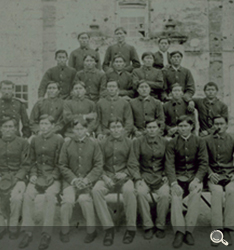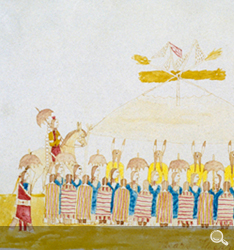

The History They Kept
Most drawings focused on warrior deeds and exploits—attacking, killing, or counting coup on enemies—and on warriors’ injuries and death during battle with Indian and non-Indian adversaries. Many drawings illustrate specific engagements; others are more general. The images also show the men’s lives as horsemen and hunters. Horses appear in almost every picture, signaling their importance in Plains life. Equally prominent are portraits of the buffalo that provided food, shelter, clothing, and spiritual sustenance.
The men also portrayed detailed remembrances of cultural life before their capture, including courting women, and the Sun Dance and other ceremonial events—all soon to be banned by the United States government.
The Fort Marion prisoners also drew pictures of the events leading to their imprisonment and daily life as prisoners. They documented sights and experiences—tourists, railroad bridges, and shark fishing—new to them. They showed themselves in the very process of change, in the forced abandonment of the lifeways they valued.
Richard Henry Pratt and Indian prisoners at Fort Marion, Florida Unknown photographer, about 1878 Courtesy National Anthropological Archives, Smithsonian Institution
Front row, left to right: Little Chief, Shave Head, Nick, Buzzard, Koba, Tounkeuh, Ohettoint
Second row, left to right: Captain Pratt, Tsadeltah, Matches, Buffalo Scout, Tsaitkopeta, Soaring Eagle, White Bear
Third row, left to right: Bear’s Heart, Zonekeuh, Roman Nose, Squint Eyes, White Man
Top row, left to right: Cohoe, Making Medicine, Zotom
Photograph identifications from Karen Daniels Petersen, Plains Indian Art from Fort Marion, University of Oklahoma Press, 1971
Catching a Shark, July 1875 Bear’s Heart, Southern Tsitsistas/Cheyenne, about 1875 Courtesy National Museum of the American Indian
On the Lookout for GameKoba, Wild Horse, or Etahdleuh (Kiowa), drawn between 1875 and 1878 at Fort Marion, Florida
(Above left) Bear’s Heart’s drawing of a Cheyenne Sun Dance or Medicine Lodge gathering offers a partial view of the most sacred of Cheyenne (and Plains) ceremonies. This multi-day, highly complex event is represented here by the Sun Dance lodge, its cloth and tree branch offerings flying, which draws the people to stand outside and bear witness to the sacred offerings being made inside. Four Sun Dancers, painted yellow, stand ready to make their sacrifices in the Lodge. Four men, probably warrior society officers, guard the lodge …their hair ornaments, bone breastplates, German silver trailers, red breechcloths, and eagle feathers indicating their status.
(Above right) This illustration by Koba shows a band of Kiowa traveling to the right. Both men and women carry various supplies, bow and quiver cases, rifles, and umbrellas (a popular trade item). The route of the band is imaged using dashes on the ground. A scout keeps a lookout on the highest hill. They hunt on foot, in the old way, though they use both old and new weapons.



